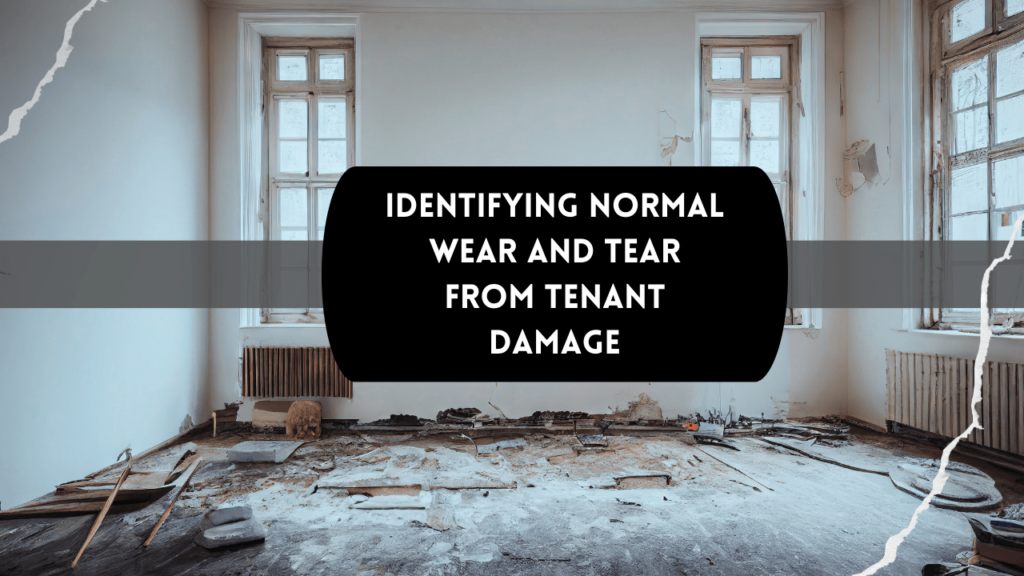
As a professional Santa Rosa property management company, we spend a lot of time inspecting properties after tenants move out. We are intentional and careful, with carefully documented checklists, photos, and sometimes videos. It’s important to us and our owners that we carefully document property conditions.
Next comes the decision on how much of the security deposit to return to the tenants who have recently moved out. Sometimes, it’s an easy decision. The property is left looking almost exactly as it looked before move-in, and we can appreciatively refund the deposit and quickly prepare it for a new resident.
Sometimes, we can see with clarity that we’re not dealing with general wear and tear, but with damage.
Sometimes, it’s a bit of a grey area.
Identifying normal wear and tear from damage isn’t always an exact science. Our expertise is a huge resource for owners and investors who struggle to know what they’re looking at.
Let’s take a look at the difference.
What is Wear and Tear in a Santa Rosa Rental Property?
Wear and tear is the general deterioration that happens to a property regardless of who is living there. Many of your systems, functions, and appliances have general lifespans. You can expect a paint job to last about three years and you can expect your carpets to need replacing after five years. Windows will give you up to 20 years and a roof should live until it’s 20.
Every property experiences wear, and that’s why tenants cannot be held accountable for the results of it. There’s often little that can be done to prevent it. Thus, rental property owners are responsible for paying for the general wear and tear that’s discovered after a tenant moves out.
Specific examples of normal wear and tear might include:
- Watermarks and scratches on counters.
- Small nail holes in the walls from where pictures were hung.
- Loose grout between tiles, especially in the bathrooms.
- Doors or cupboards that have warped from humidity.
- Faded paint.
- Door frames or window frames that may have warping.
- Blinds that may have faded from sunlight.
- Scuffs or dents in walls behind doors (from door handles).
- Minor carpet staining or discoloring.
- Slight scrapes or marks on a hard floor.
- Finishes wearing away, staining or rusting.
- Light scratches on windows.
These are not things you would normally charge for when a tenant moves out and you’re preparing the property for a new resident. You’ll make your repairs as well as your upgrades and updates designed to make your property more appealing.
Think about ways that you can improve your rental property and increase the rental value. For example, pulling up the carpet because it’s worn gives you an opportunity. Instead of installing new carpet, consider putting in tile. It will last four or five times as long as carpet.
The longer a tenant occupies your property, the more wear and tear can be expected. If a tenant has been in place for 10 years and the walls have not been painted in that entire decade, you’re going to expect that you’ll have to repaint before a new tenant moves in.
What does Property Damage Look like in a Santa Rosa Rental Property?
Property damage is different from wear and tear.
Damage, whether it’s intentional or accidental, is likely to harm the value, usefulness, or normal functions of your rental property. It needs to be repaired before the home can be rented again.
Property damage that’s discovered in the course of a move-out inspection is the tenant’s responsibility. You can withhold funds from the security deposit in order to pay for the damage you detect and document during your inspection. This is typically the result of abuse and neglect, not ordinary use.
Examples of property damage may include:
- Large holes in the walls or floors.
- Changes to the property, such as different paint colors that were not pre-approved.
- Tears, stains, or holes in carpet.
- Counters that are chipped, burned or stained.
- Water stains on wood floors.
- Broken appliances, doors, or windows due to abuse.
- Missing or cracked bathroom tiles and mirrors.
- Writing on walls, floors, and surfaces.
You can charge a security deposit for trash that’s left behind, furniture that’s not moved out, or changes that were made to appliances or walls. If window screens have been removed and never replaced, you can charge the deposit.
When you’re withholding money from the security deposit to pay for these things, document the amount you’re spending and why. You’ll need to provide an itemized list to your tenant that explains why they aren’t getting the full deposit back – or any deposit at all.
Documenting Move-in and Move-out Condition
Your ability to distinguish normal wear and tear from tenant damage will depend on the way you document the condition of the home. Your move-in inspection and checklist are critical in order to compare the condition of the property to its move-out condition. When you work with a Santa Rosa property management company, you can expect that a thorough survey will be conducted to effectively protect your property and distinguish between wear and tear and damage at the end of the tenancy.
One of the benefits of having this completed by a property manager is that professionals stay up to date on the legal requirements and shifts in court trends. You want to know what a judge will think if a tenant disputes your security deposit charges and takes you to court.
Remember that in California, you’re legally required to offer your tenants a pre-move-out inspection before they vacate the property. Tenants don’t always accept this offer, and we know a lot of landlords don’t love doing them.
But, it can be helpful.
You should look at it as an opportunity to prepare your tenants for the deductions you may take. When you’re walking through the property together, you can point out those problems that clearly go beyond wear and tear. Your tenant will be less likely to dispute the charges you make against the deposit.
This also allows you to get a sneak peak of the work that might be necessary before the property is ready to rent again.
Avoiding Disputes with Santa Rosa Tenants
It’s easy for landlords and tenants to get defensive over the security deposit. Typically, most conflicts between landlords and tenants involve the security deposit. Tenants will always expect to get their full deposit back, and they get upset if you keep any money to pay for damage to the property. This illustrates the need for good documentation.
We also know there are landlords out there who think everything should be considered damaged, including those small nail holes and scuff marks. You have to be fair. And more important than fairness is consistency. You must be consistent in what you deduct and what you do not.
Here’s how you can best avoid disputes and legal battles:
- Take exhaustive photos of the property before your tenants move in. You’ll want to account for every wall, floor, ceiling, and surface. It’s hard to argue with photos.
- Make sure your inspection report is thorough, signed by the tenants, and filed away for the end of the lease term. You’ll want to leave the move-in inspection report with tenants for a day or two so they have an opportunity to note any problems they find.
- Encourage your tenants to have a pre-move-out inspection before they leave.
- Conduct a move-out inspection after tenants leave that follows the move-in documentation.
Before you deduct for damage, there should be no doubt that it is the tenant’s responsibility and not normal wear and tear. Security deposit laws in California are strict, and if you fail to follow them, you could find yourself paying some hefty punitive damages. The tenant could be awarded up to three times the amount wrongfully withheld, plus reasonable attorney’s fees and court costs. That’s going to add up to a very expensive mistake. When a tenant comes to you with questions, explain in detail why you made the deductions you made. Think about the strength of your case and whether you want to risk a court date.
If the tenant has the intention of filing a legal suit against you, they are required to notify you before they do. Use those days to return any amount that may have been wrongfully or unintentionally withheld. It will save you from having to go to court.
Arguing with tenants about whether something is wear-and-tear or damaged will end up frustrating and expensive. We are not suggesting that you back down every time a tenant raises an objection, but make sure you can adequately prove your case.
 We know this can be stressful, and we are here to help with your move-out process and any of your Santa Rosa property management needs. Please contact us at Prestige Real Estate & Property Management. We manage homes in Sonoma County, including Santa Rosa, Windsor, Sebastopol, Petaluma, and Rohnert Park.
We know this can be stressful, and we are here to help with your move-out process and any of your Santa Rosa property management needs. Please contact us at Prestige Real Estate & Property Management. We manage homes in Sonoma County, including Santa Rosa, Windsor, Sebastopol, Petaluma, and Rohnert Park.
